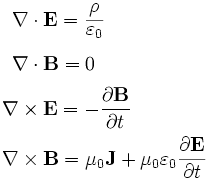If you were on the MIT campus for any length of time, sooner or later you would encounter Maxwell's Equations. Usually the moment occurred in Spring semester of the freshman year, in 8.02 class, which was Electricity and Magnetism and was a requirement (Well, it or one of the other related classes - 8.021, 8.022 or 8.023; we always called them Physics for Poets, Eight-oh-Two-Screw or Physics for Pre-Meds). Those who entered Course 6 would live with them for the rest of their undergraduate years. There were four of them, and they all had significance in the field of electromagnetic theory. They were named for James Clerk Maxwell, and they described electromagnetic fields. The first was Gauss's Law, the second was Gauss's Law for Magnetism, the third was Faraday's Law and the final one was Ampere's Law.
In their ordinary physics form, the integral form, Maxwell's Equations looked like this:
![[Maxwell's equations]](http://www.physics.udel.edu/~watson/phys208/formulas/maxwell.gif)
In the form that most electrical engineers found them, which was the differential form, they looked like this:

Or they could be found like this:




But there were other forms of the equations, as demonstrated by Ross:
There was one final form:
By the way, the funny round black object is called a long-playing record. It was used to play recorded music on something known as a record-player (hip-hop and techno DJ's call them turntables or wheels of steel and use them to make scratching sounds in noisy nightclubs where alcohol, hookahs and funny green tablets are passed around and consumed). Records were popular back in the days before compact discs and MP3 files existed and they played strange music called rock-and-roll that certain religious officials objected to. There were even claims you could play records backwards and hear voices from Satan, but everybody knew it was just Ozzy Osbourne. No one has yet tried to play an MP3 file backwards.
A popular shirt, sold by the Hillel Society, had the following message printed on it:
And God Said:




and there was light
and there was much rejoicing.




No comments:
Post a Comment